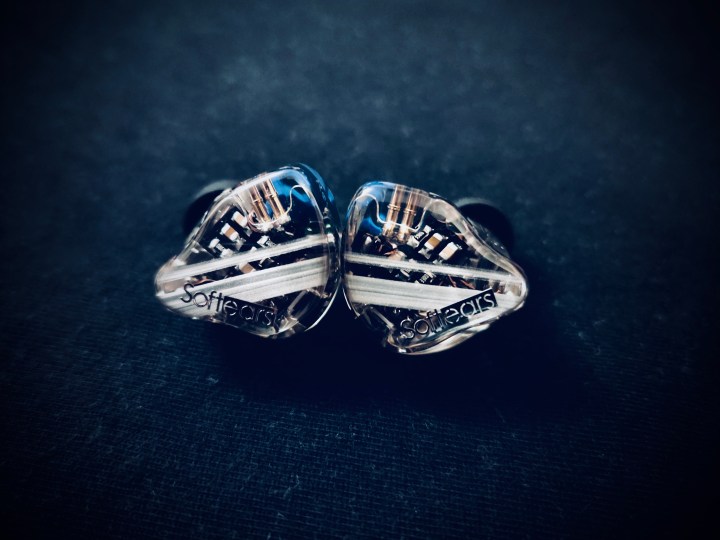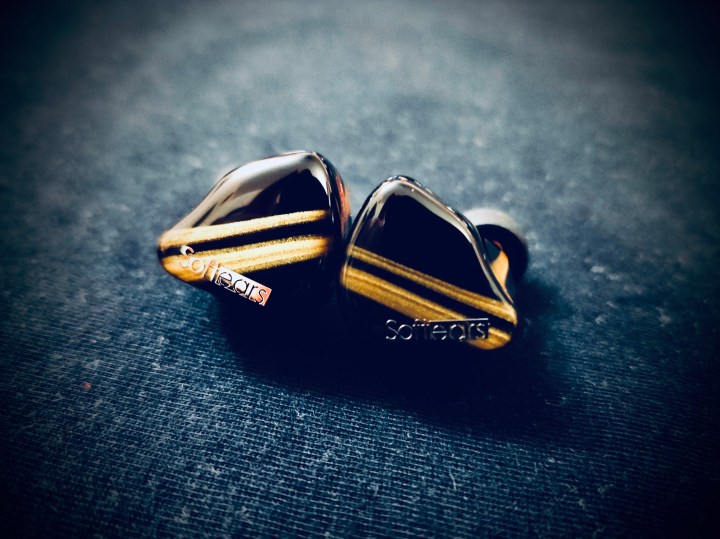Softears’ Flagship Bros.
PROS: RS10 – Excellent craftsmanship, build and finish, very well tuned reference IEM, very good tonality and timbre, good bass performance, forward upper-midrange with 10dB pinna gain, neutral treble presentation, good resolution and separation, noise isolation. Cerberus – Excellent craftsmanship, build and finish, very nice linear bass shelf, sub-bass rumble, nice natural sounding midrange with 8dB pinna gain, clean centre image, good separation for a warm tuning.
CONS: RS10 – Not the biggest soundstage in the price segment, big shells maybe be troublesome for small ears, only 1 set of SML stock tips; needs more variety in stock ear tips. Cerberus – A bit too warm a tuning as 5k-15kHz treble region needs more gain to achieve a good balance, big shells maybe troublesome for small ears, only 1 set of SML stock tips; needs more variety in stock ear tips.
About Softears.
Softears is closely associated with the highly popular Chinese company – Moondrop, as they share a lot of R&D and manufacturing assets while remaining sister companies that run their business independent of each other. As per what I’m told, Softears’ CEO is actually an automobile engineer by education who joined Moondrop after completing his studies. Moondrop’s founder, Herbert invested in him to create a no boundaries, no budget restrictions R&D brand, Softears, to see what could be achieved if money was no object. If you haven’t noticed, Moondrop’s IEMs like Blessing2 and S8 use Softears developed drivers for the reference quality midrange they are particularly known for.
We previously reviewed their 5BA reference IEM – Softears RSV. Today we’re checking out Softears RS10 and Cerberus. Both are priced at $2100.
Links – Softears (Official Website) | Softears AliExpress Store | MusicTeck (Softears’ US Distributor)
The product was provided to me free of charge for the review in exchange for my honest opinion.

Technical Specifications.
RS10
- Drivers – 10 Balanced Armature drivers
- Frequency response – 20 – 40kHz
- Sensitivity – 100dB/mV @ 1kHz
- Impedance – 25Ω @ 1kHz
- Distortion – THD<1%, IMD<1%
- Socket – 0.78mm 2pin
CERBERUS
- Drivers – 1DD+4BA+2EST
- Sensitivity – 104dB/100mV@1kHz
- Impedance – 5Ω@1kHz(±15%)
- Frequency response – 10 – 80kHz
- Distortion – THD≤1%, 1MD≤1%
- Socket – 0.78mm 2pin
Included in the box.
- Softears IEM
- 4 core cable
- Silicone ear tips SML
- Leather case
- Manual
- Warranty Card
- Cleaning cloth
Build Quality.
RS10 is made with medical grade resin but its build, design, fit and finish are executed to very high standards. It has clear shells with parallel white stripes and brand name ‘Softears on the faceplate and 2-pin sockets for the detachable cable. The clear shells are ultra clear and are finished perfectly without any bubbles, smudges or any imperfections. Thanks to the clear shells, you can see all the drivers and immense amount of tech on the inside. These are definitely the most spectacular clear shells I’ve had the pleasure of reviewing.
Cerberus on the other hand has black shells with gold swirl design. It has parallel gold stripes with the brand name ‘Softears’ on the faceplate and vent for the dynamic driver on the side below the 2-pin sockets.

Cable – Both RS10 and Cerberus come with the same silver-plated copper cable. It has a clear sleeve, is soft and supple with minimal microphonics but is definitely not up to the standards of RS10 and Cerberus’ premium $2k pricing. It’s basically the same cable that comes with $500 BGVP NE5. In fact, I like $730 RSV’s cable more than this one. Most brands these days try to include a nice, premium, known brand’s cable with their IEMs above $1500, so Softears should definitely offer a more premium cable with their $2000 IEMs. But then you also have brands like 64 Audio whose IEMs come with an even cheaper and much worse looking cable. So, if that’s the reference of comparison, this cable is definitely not a problem!

Case – RS10 and Cerberus comes with a very nice hockey puck style leather case. RS10’s case is black while Cerberus’ is green. The case is quite roomy on the inside and comfortably fits the IEMs with the cable.
Fit and Comfort.
For reference, I have medium-large sized ears. Both RS10 and Cerberus’ shells are on the large side but have a nice semi-custom design. They fit me quite comfortably but RSV is the snuggest of all for me, out of the Softears lineup. It has less shell depth which I think is a contributing factor to it having the best fit. Still, in the larger scheme of things, both RS10 and Cerberus are fairly snug and remain comfortable for hours. The passive driver definitely helps in attenuating ear pressure and keeping them easy on the ears. Even though Cerberus has a vent for the dynamic driver, both are quite good at noise isolation and should work well for monitoring in noisy environments.
In general, just beware that RS10 and Cerberus’ shells are bigger than Moondrop’s Blessing2, S8 and even RSV depth wise. So, if you have small ears and the Moondrop shells were big for your ears, these shells might not be best for you. Still, one can only know for sure by trying ’em out.

Tech Inside.
Common Tech between RS10 and Cerberus.
Passive Driver for Ear Pressure Relief and other things – One of the major creative design in Softears lineup is the implementation of passive drivers. This unit is not counted in the driver count and is designed to vibrate passively with respect to other BA units. It doesn’t produce sound but attenuates ear pressure, relieves stress for wearing, enhance bass texture, reduce hearing fatigue and protects hearing.
Tech in RS10.
Softears Custom D-MID-B Driver – This driver has a frequency response that’s highly compliant with VDSF Target response and has ultra low distortion. Softears engineers elevated its performance further with circuitry that focuses on easier-drivability and a more natural sound.
Crossover Design – The Softears RS10 uses a 5-way crossover design that features excellent performance in regards to the frequency-time domain as well as impedance, that even challenges high-end reference loud speaker designs. This crossover consists of 2 band-pass filters, a low-pass filter and even a 4th order LC filter to precisely control the impedance and frequency characteristics. As a result, the RS10 has near-perfect phase-impedance consistency across the audible frequencies. Softears specially focused on reproducing the higher midrange frequencies so that they precisely match the natural hearing of human ears under studio conditions. The complex crossover design of the RS10 was painstakingly streamlined by their engineers to bring it down to 15 components into two modules. This further optimisation process minimises interference between the components and increases the efficiency so that the RS10 is less difficult to drive.
Flat Impedance Design – If you aren’t aware, high impedance sources can skew the sound signature of some sensitive IEMs and that can be a troublesome affair if you like plugging IEMs into a variety of different sources. The most popular example of this is Campfire Andromeda’s signature turning wonky and sounding horrible with high output impedance sources. Compared to other multi-driver IEMs, RS10 has an ultra low impedance fluctuation across the audible spectrum and keeps its sound signature unaffected from impedance differences between sources. So, you can plug it into high impedance sources like Pro-audio interfaces and even mixing consoles, and its sound signature will be unaffected by their output impedances, which makes it an excellent design not just for professional musicians and audio engineers wanting a monitor that can be plugged into everything without a worry but also audiophiles who like to use a variety of sources, some of which don’t have ultra-low output impedances.

Tech in Cerberus.
BA drivers specifically made for Cerberus – Softears collaborate with an adventurous BA driver manufacturer in China to develop specific drivers to meet Softears’ stringent expectations of hitting certain target curves and characteristics for the products they’re developing. The BA driver in Cerberus was designed to complement the Dynamic and Electrostatic drivers used in Cerberus. This driver combo is a quad-drive all in one package to deliver rich and full sound.
Proprietary Dynamic Driver – Moondrop, the company behind Softears has years of experience in developing dynamic drivers. They developed the perfect bass driver with great performance to meet the target curve they were targeting for Cerberus. This is a 10mm dynamic driver with carbon fiber + paper dome with long linear excursion, high sensitivity and fast response.
Page 2 – RS10 – Sound analysis & Comparisons.
Page 3 – Cerberus – Sound Analysis, Comparisons and Conclusion.




How does the RS10 compare to the u18t?
LikeLike
What cable would you suggest for rs10? Right now I’m using plussound exo spc but it’s losing its braiding (twist) so I’m considering a upgrade.
I love how rs10 sounds nearly identical to the mastering studio I work at, and I would love to keep it that way. Right now I’m considering tri-silver, would love to hear some other suggestions as well.
Thanks a lot!
LikeLike
Hey there! I myself am not too big on extremely expensive cables. I generally use the RS10 with Ego Audio Whiskey, PWA No. 10 or EA Ares II.
LikeLike